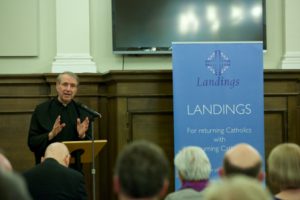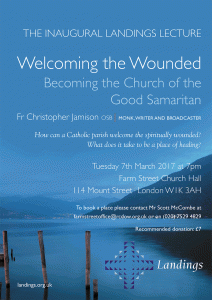CAP Poster Training Day 25 June 2019
Continue reading “Communicating the Word in our communities in preparation for the “Year of the Word””
Welcoming the wounded: Becoming the Church of the Good Samaritan
The Landings Lecture by Fr Christopher Jamison OSB, 7th March 2017

1. Who are we talking about?
Let’s begin by recalling the main characters in the parable of the Good Samaritan. The traveler, the bandits who beat him up, the priest and the Levite who pass by on the other side, the Good Samaritan and the inn keeper. This evening let’s focus firstly on the traveler as representing those beaten up by the world and, most distressing of all, those beaten up by the Church; secondly we’ll focus on the Samaritan, the unlikely person who, together with the inn keeper, offers healing and hospitality.
So in order to be the church of the Good Samaritan, we need first of all to have some sense of who is lying by the roadside and how they have been beaten up.
The groups I have in mind as the scope of this presentation are not Catholics no longer connected to the Church through simply lapsing; Landings already has resources and examples of how to welcome them. This evening I want to focus on those who are wounded either by our culture or by the Church itself. I appreciate that the distinction between the simply lapsed and the wounded isn’t clear cut. We’re looking at a spectrum with simply lapsed at one end and deeply wounded at the other with plenty of lapsed and wounded people in the middle. So let’s simply agree that this evening we’ll look at the deeply suffering end of the spectrum.
For example, some older people describe their experience of being at a Catholic school as a nightmare. They’re deeply upset by the memory. What can we offer them? Or the unmarried mother with a partner who rarely goes to Mass but is looking for spiritual help. Or the transgender Catholic trying to find how they fit into the Church and the parishioners who find this difficult to handle.
What strikes me about these examples is that nowadays, no matter what our Catholic teaching says, more and more people no longer see their lives as fitting classic categories: married/unmarried, male/female, loyal Catholic/lapsed Catholic. English society’s daily life used to be built upon a traditional Christian values system; even when people’s church attendance diminished, the basic structure of English life remained unchanged. Part of the bed rock of the Catholic Church in England was the traditional English culture and that Christian culture of family life supported the Catholic Church’s culture. But the old categories have now dissolved and in London especially there is no longer any such thing as normal. This has impacted the English Catholic Church. In order to understand how local churches can help the wounded, we need to understand how the Church itself has changed in the last 50 years.
2. Past Church
To understand the Church in this country, we need to recognize the decline of the totally catholic culture (TCC); along with all total cultures, this began to die from 1960s onwards. This is the world of the parish providing Catholic families with schools, youth clubs, football teams, social clubs etc; I grew up in this all embracing Catholic culture and, and unlike some people, I found it a very positive experience. But along with all total cultures, TCC began to die from 1960s onwards. The 60’s was the time when the young no longer took their values from just one place; with the era of TV and mass tourism, new vistas opened up and the young embraced them with enthusiasm. No longer could people be brought up within one culture and we saw the decline of Jewish and Anglican culture as well. The final blow to the TCC was the failure of the church to deal properly with abusive clergy. The effects of the death of the TCC are seen in the statistics; between 1980 and 2000, the numbers at Mass on Sunday halved from around 2 million to around 1 million. In the new millennium, faith is no longer inherited but chosen. Catholic families and schools now pass on the possibility of faith to the young, which is a great gift in a world that is stunningly ignorant of religion. This possibility is passed on so that young people may become the adults who pass on the faith to other adults. We now have intentional Catholics in Church or they aren’t there at all. But one of the problems is that many of the million wonderful people at Mass on Sunday think that the storms of the last 50 years will pass and a version of the TCC will return. That isn’t going to happen. The Catholic Church is now no longer supported by English culture nor can the faith be passed on simply as a family inheritance.
3. Future Church
So what will be the distinctive features of local communities in the Catholic Church? (Local communities is the term I’ll use to cover parishes, chaplaincies and religious communities.) The TCC delivered people to church on Sunday and those in need knew where to find support within the culture. By contrast, most people are now brought up at a distance from all religion or distance themselves from it. So the first task of a local community is to shrink the distance between most people and the church. We have to work hard to enable people to approach the Church. That means a key feature of the church in future will be hospitality. If you take away nothing else this evening, take away the thought that to be the church of the Good Samaritan means being the church of hospitality. Pope Francis wants parishes to be field hospitals and that’s a great image for a parish that wants to care for the wounded. But in the parable, the Good Samaritan takes the wounded man to an inn not a hospital so I will leave to one side the medical image and stick with hospitality. Running an inn is less daunting than running a hospital!
While welcoming people to the liturgy is important, Sunday Mass is the culmination of Christian hospitality not the starting point. Offering hospitality in its fullest sense is in itself a service not simply an exercise in keeping people coming to Mass. Nowhere is this clearer than in my own monastic tradition. In the Rule of St Benedict for monasteries, the chapter on receiving guests (ch 53) says that ‘all guests are to be welcomed as Christ.’ They are to have their feet washed and be shown ‘every kindness’ which translates the Latin word humanitas literally humanity. What a challenge: for a Christian community to show humanity to all. Benedict continues: ‘great care and concern are to be shown in receiving poor people and pilgrims, because n them more particularly Christ is received.’ The theology of hospitality must be the foundation of the Church of the Good Samaritan. To receive the wounded is to receive Christ himself and it is to offer healing in the simple act of hospitality.
4. Future Parish
So what does all this mean for local communities? Risk is the quality that moves us forward so I now want to describe what this risk looks like on the ground. How can a local community offer hospitality to new groups of wounded people? And in doing so I’ll show how a parish becomes the church of the Good Samaritan, focused around a culture of hospitality and healing. It means that the primary focus of a future parish will move away from trying to recreate the now passed TCC and move to fostering a culture that looks outwards with unrelenting energy. The parishioners will reimagine themselves as the creators of a place of outreach to welcome two groups of people: firstly, those at a distance from the church who want to learn about faith; secondly, those who need help with wounds of all kinds. These two activities are more closely linked than many realise because faith heals. With projects like Landings and programmes such as Alpha, together with so much social support activity much work is being done already in our parishes. So I want to highlight three groups of wounded people that a parish looking to be a hospitality parish might consider for special attention. They are: wounded citizens, wounded Catholics and wounded souls.
Wounded citizens: Parishes can identify the places where government has retreated from people with wounds. The clearest example of where this has already happened is food banks; local Christian communities are the back bone of these sadly necessary schemes. The fruitfulness of such initiatives should encourage us to look around for new opportunities. e.g. detached work with alienated youth. Local authorities have reduced youth work provision and there are too few people out on the streets engaging with young people at risk from a variety of dangers, dangers that include being literally beaten up on the road by gangs. For some young people, the Good Samaritan story isn’t a parable, it’s a documentary. To prevent that, we need to walk with them along the road, inspired by another bible story, Jesus on another road, this time to Emmaus. A group of us have been working with a pilot parish to devise safe ways for parishioners to fulfill the role of Christ on the road to Emmaus. With training, parishioners can become the stranger who walks alongside disheartened people and goes with them into the inn to share hospitality. A road, a stranger and hospitality. The pattern found on the roads to Jericho and Emmaus is walking the road and offering strangers hospitality at the inn. That is the biblical model for the hospitality parish of the future.
Wounded Catholics. We can also identify the places where there are too few people providing welcome to Catholics with certain wounds e.g. transgender Catholics who feel isolated. More widely, you’ll be familiar with Catholics who stopped going to Church when they got divorced. Or single parent mothers who stopped going to Church when they became pregnant outside marriage. This situation can be turned round. There is a remarkable documentary made for BBC THREE some years ago called Kizzy: Mum at 14. This tells the story of 13 year old Kizzy who became pregnant, was mocked by her peers and received little help from her school which she left. When the baby was born, she asked not only for the baby to be baptized in a Catholic church but she asked for her own baptism too as did the child’s grandmother. When asked why, Kizzy said ‘because the Catholics were the only ones who were nice to me.’ The power of hospitality.
Wounded souls: Prof Peter Tyler is a psychotherapist and theologian who sees in the myth of Parsifal a model of the spiritual life of the young person[1]. He cites evidence from his own practice and from research that between the ages of approx.12 and 25 everybody has a religious experience. Like Percival when he finds the Holy Grail, they ask: what does this mean for me?[2] This is the wrong question. Because most young people are spiritually ignorant, especially today, they can’t handle the religious experience and like Percival they carry the wound of the mishandled spiritual encounter into middle age. The right question is: ‘whom does the Grail serve?’ or ‘whom does this religious experience serve?’ The purpose of spiritual accompaniment is to help people ask the right questions; in time we can help them ask the right Holy Grail question: whom does the Grail serve? And in God’s time they can come to know the answer: Jesus Christ is the one whom the Grail serves. This Holy Grail experience is a touch of the transcendent in the midst of life; it is the experience of the fundamental and innate human vocation to love. I know a good number of young people who have gone to visit a developing country or even just a care home and it changes their life as they meet the call to love, the Holy Grail moment. But how many people are just confused by that experience and see it as simply something weird. We need to see evangelism as an offering of healing to the wounded. Yes evangelism not only evangelization, because what those who carry the Grail wound lack is somebody who can explain faith and offer theme a language with which to make sense of their spiritual experience. Most young people in England today are born and bred as atheists. We need to offer them hospitality to help them process their Grail experience and heal the Grail wound.
Conclusion
This is a lot of wounded people and you could probably describe even more. Pope Francis finds a new group to embrace and welcome almost every day. So these are offered as examples for you to consider not as a comprehensive programme. If you are here tonight, you are probably already engaged in many projects like this. So this is to encourage you and to embolden you. If you want to see how a diocese is embracing this approach there is the programme called Love in Action being rolled out across Westminster diocese. The wonderful web site is www.stepforwardinlove.org In our discussion I look forward to hearing about your experiences of becoming the church of the Good Samaritan.
[1] The Disciples’ Call ed Christopher Jamison, ch 11 The Psychology of Vocation: nurturing the Grail quest P Tyler
[2] “Every youth blunders his or her way into the Grail castle sometime around age 15 or 16 and has a vision that shapes much of the rest of their life. Like Parsifal, they are unprepared for this and do not have the possession to ask the question that would make the experience conscious and stable within them.” (Me: Understanding Masculine Psychology R. Johnson 1989)
Welcoming the Wounded © Christopher Jamison OSB
Inaugural Landings Lecture: London
By Helen Carvalhido-Gilbert
 Welcoming the Wounded:
Welcoming the Wounded:
Becoming the Church of the Good Samaritan
Tuesday 7th March 2017 at 7pm
Fr Christopher Jamison, OSB
Monk, Writer and Broadcaster
How can a Catholic parish welcome the spiritually wounded? What does it take to be a place of healing?
Farm Street Church Hall, 114 Mount Street, London W1K 3AH
To book a place please contact Mr Scott McCoombe at farmstreetoffice@rcdow.org.uk or on (020) 7529 4829
Recommended donation: £7
Landings taster workshop in Beaconsfield: Saturday 19th March, 10am
By Ian Johnson
This workshop will offer a taste of Landings and demonstrate the power of the Landings process and how it helps returning Catholics. All welcome – potential returners or ‘welcomers’ alike, or those simply interested in recommending Landings to others.
Saturday 19th March at St Teresa’s, Beaconsfield, starting at 10 am and finishing between1-1.30 pm with a mid-morning break for refreshments.
No commitment will be asked for but, if you are thinking of attending, please phone or e-mail so we can gauge numbers. Please call Maggie or Ian on 01753 482496 or mail maggiemillrain@icloud.com.
Farm Street launches Landings
By Ruby Almeida
 As the new hub for Landings UK, Farm Street parish in Mayfair, London, is hosting an introductory session to Landings on 4 separate November evenings.
As the new hub for Landings UK, Farm Street parish in Mayfair, London, is hosting an introductory session to Landings on 4 separate November evenings.
Anyone who is thinking about returning to the Catholic Church after a time away would be most welcome.
Farm Street then hope to run the Landings process itself in early 2016.

